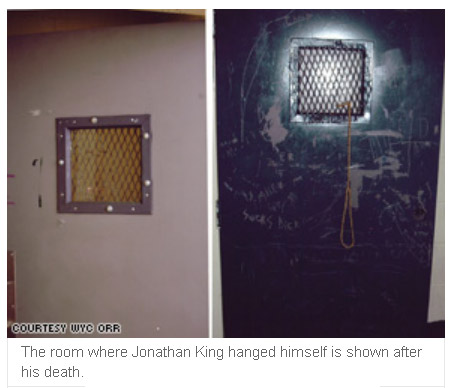 Schools cannot put children in seclusion rooms as a form of punishment anymore, and must limit the use of physical and chemical restraints. The State Board of Education approved new rules Thursday for handcuffing children, controlling them with prone restraint tactics, and giving them prescription drugs to control their behavior. These measures are now limited to situations where students are an immediate danger to themselves or others, or when calming techniques don’t work.
Schools cannot put children in seclusion rooms as a form of punishment anymore, and must limit the use of physical and chemical restraints. The State Board of Education approved new rules Thursday for handcuffing children, controlling them with prone restraint tactics, and giving them prescription drugs to control their behavior. These measures are now limited to situations where students are an immediate danger to themselves or others, or when calming techniques don’t work.
Parents of 13-year old Jonathon King of Gainesville pushed for changes after their son hanged himself in a seclusion room in 2004. Jonathan was a student in the Alpine Program, a public school in Gainesville, Ga. for students with emotional and behavioral problems. A few weeks before his death, Jonathan told his parents that teachers had been putting him in time out. They testified last month at a hearing at the Board of Education. “After he died, we found out that Jonathan wasn’t in there for minutes,” Don King said. “He was in there for hours at a time every day.”
For decades, Georgia schools have used seclusion and various types of restraints on children with autism and attention deficit hyperactivity disorder to prevent classroom disruptions. “I’ve seen handcuffs, hogties, kids being tied up with Velcro. I’ve seen kids locked in storage closets. And I’ve seen, very recently, a plywood box in a principal’s office,” says Leslie Lipson, spokesperson for the Georgia Advocacy Office, who also testified in June.
The new rules apply to all children in public schools, and get praise from Randee Waldman, director of the Barton Juvenile Defender Clinic at Emory Law School. ”Georgia is trying to address this. Georgia is one step ahead,” She adds, “Handcuffs shouldn’t be used to punish a child,”
But educators and child advocates admit they’re not sure exactly how often children are placed in seclusion, or handcuffed, or even how many are arrested in Georgia schools. Data from the Education Department indicates approximately 1,900 children statewide were referred to juvenile court during the 2008-2009 school year. However, numbers from Atlanta are missing from the count, and some experts believe the total may be significantly higher.
“We’re having a hard time figuring out how many kids are referred to Juvenile Court much less handcuffed,” says Waldman. “Schools are not required to maintain data on how many times children are handcuffed. “
That may soon change. Brad Bryant, the new state schools superintendent, tells the Atlanta Journal-Constitution he expects a data collection system to be put in place. And for the first time, parents must be notified when their children have been restrained by a school administrator or teacher.
The Board approved the new policy on the same day school officials in New Orleans were slapped with a federal lawsuit for shackling a 6-year old boy to a desk.
The first grader was arrested, handcuffed and chained up by school police after arguing with another child over a seat in the lunchroom. The Southern Poverty Law Center filed a class action lawsuit Thursday in Federal Court, claiming the arrest for a minor violation of school rules is unlawful and a violation of the Fourth Amendment to the Constitution.
The complaint names the elementary school principal, school superintendent and security director, and was filed on behalf of all children in the school. SPLC Attorney Thena Robinson says, "We’re hopeful this [lawsuit] will send a powerful message. We have to treat kids with dignity. There are ways to keep kids safe and treat them with dignity."
The boy’s father, Sebastian Weston, says his son was treated like an animal is now terrified of school.
A spokesman for the Recovery School District confirms the incident happened May 6, and two security officers were fired, but would not comment further.
The suit alleges the officers were not properly trained “about developmentally appropriate responses to elementary school children who fail to follow school rules.”
Attorneys also contend that under state law, a 6-year old child cannot be arrested, but the school principal had a policy of handcuffing children who violated rules. When the officers chained him to the furniture “they subjected him to an unreasonable and excessively intrusive seizure that was calculated solely to punish, humiliate and intimidate. “
“We cannot wrap our heads around why the principal thought it would be okay to shackle a child to a desk,” Robinson says. “So many things could have been done, even if he was getting out of control. Six-year olds throw temper tantrums. It’s up to adults to redirect them.”
